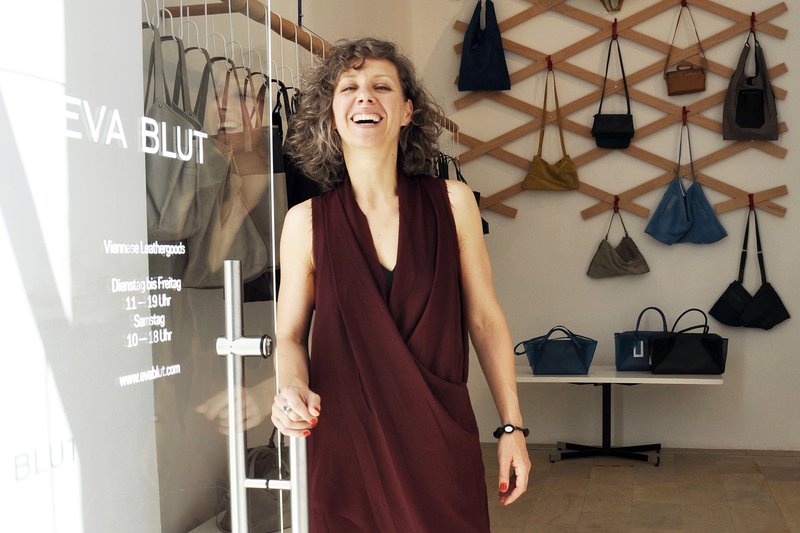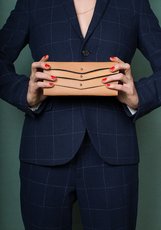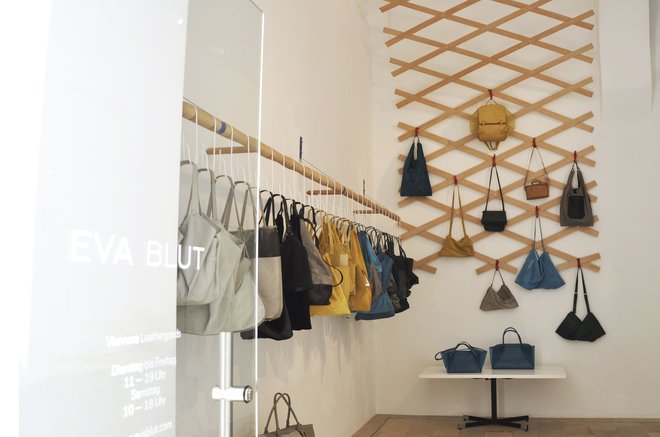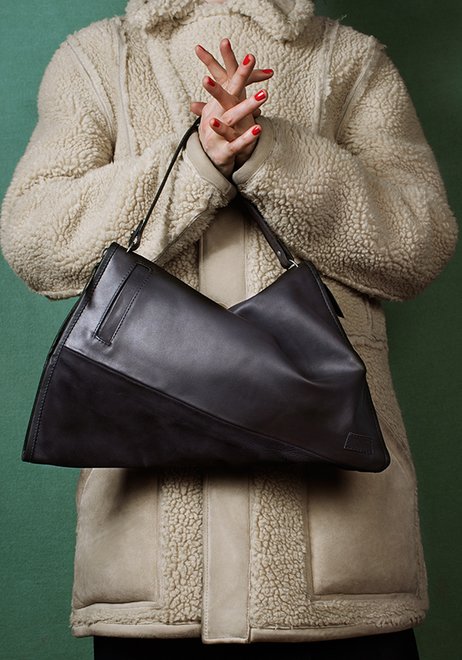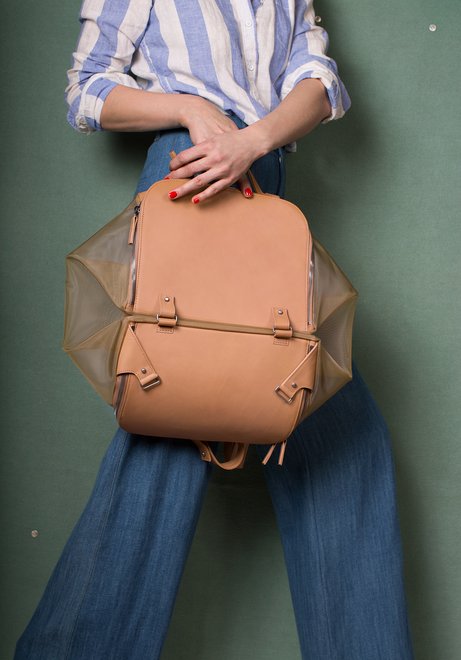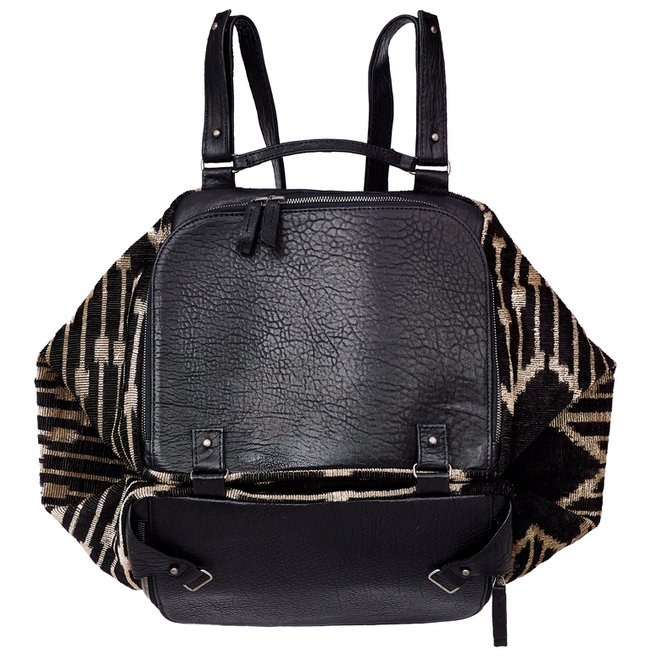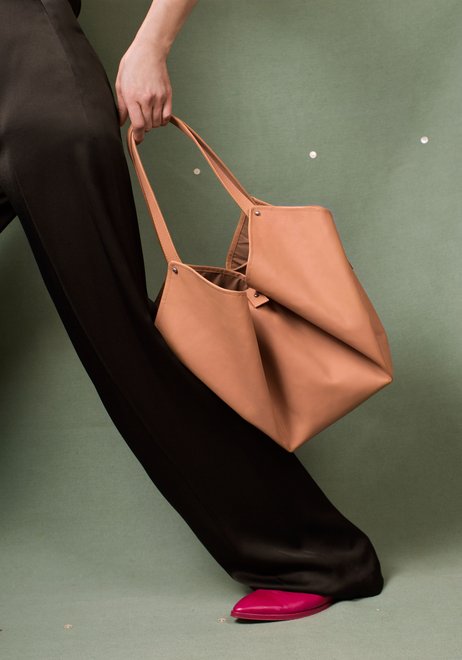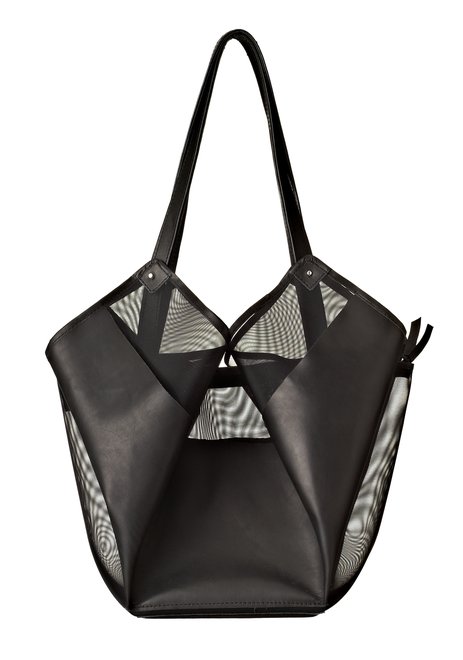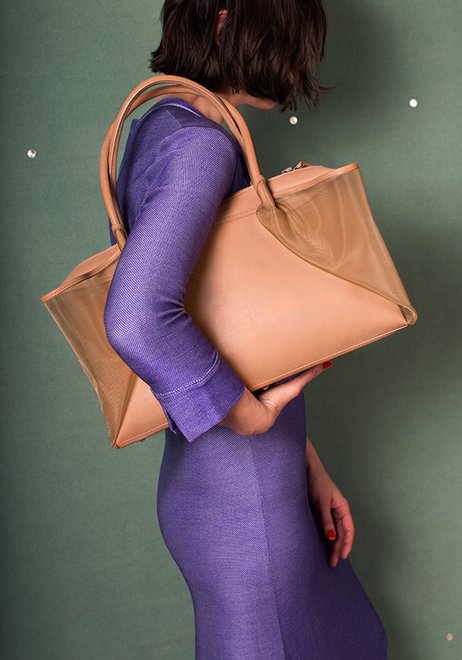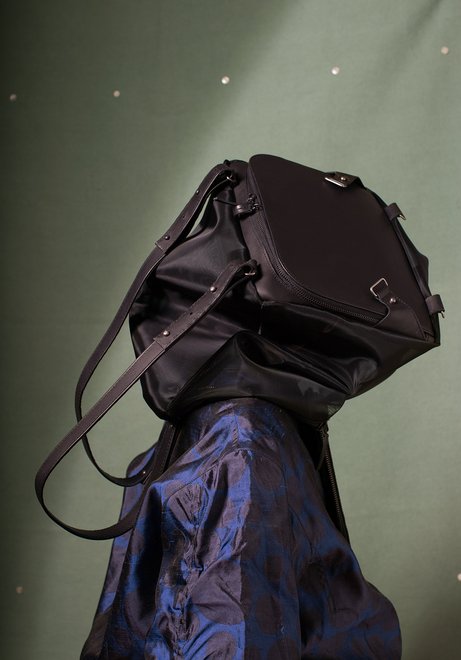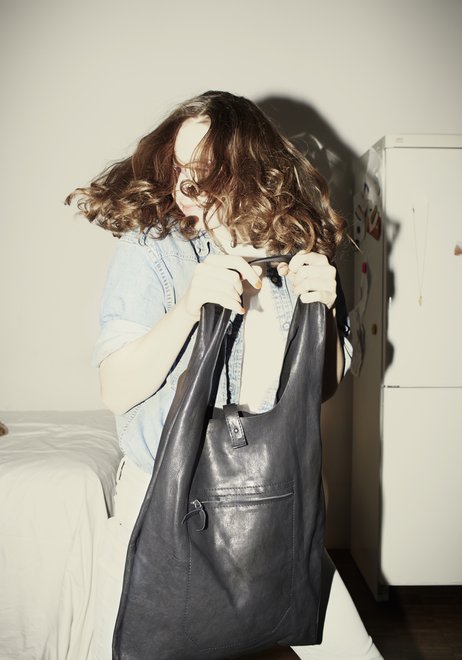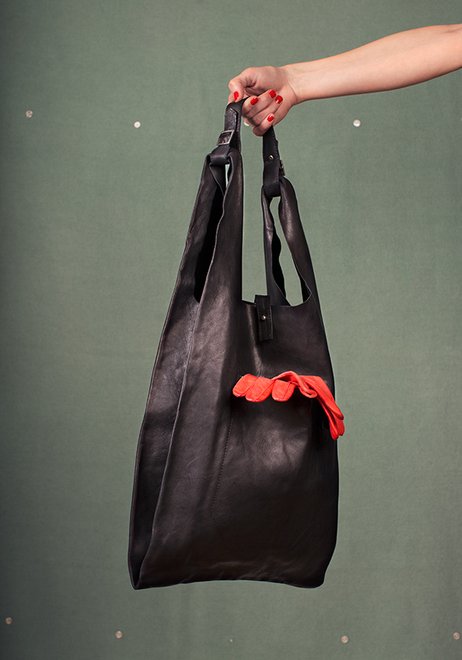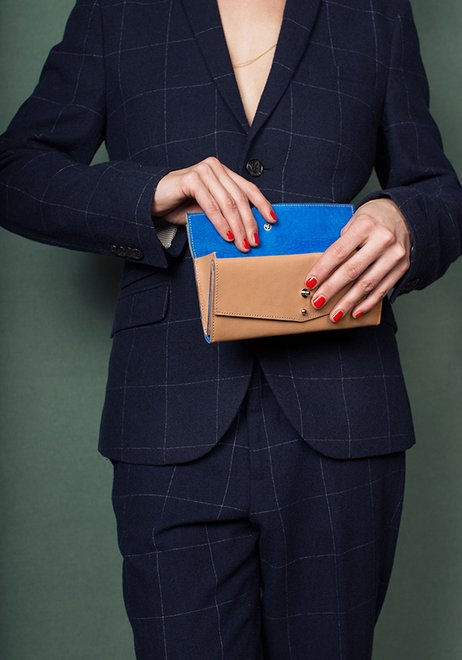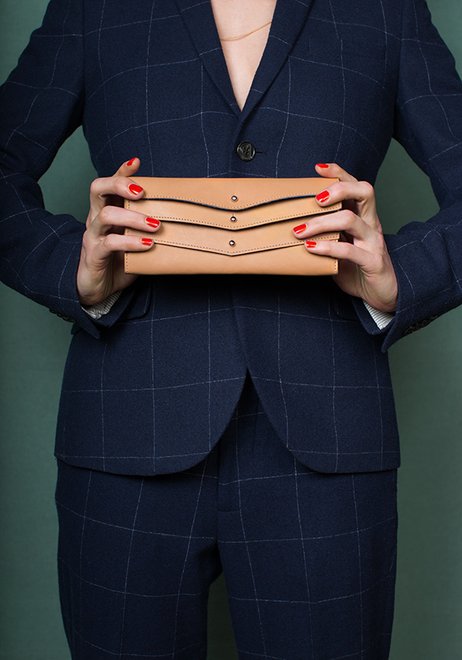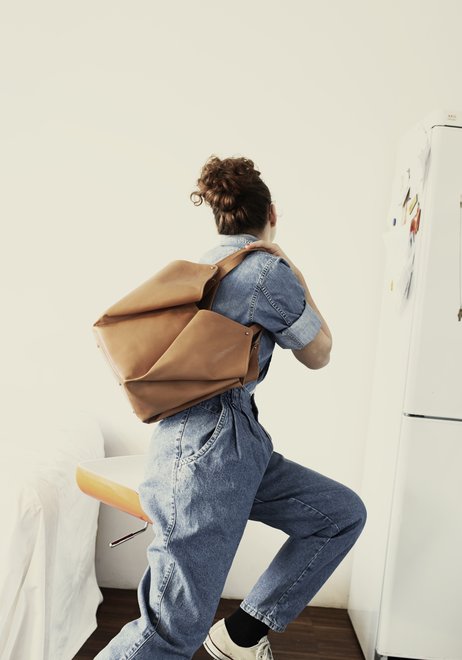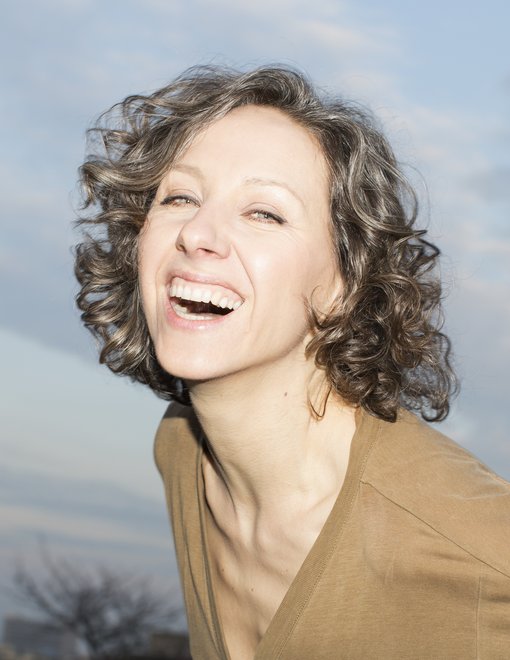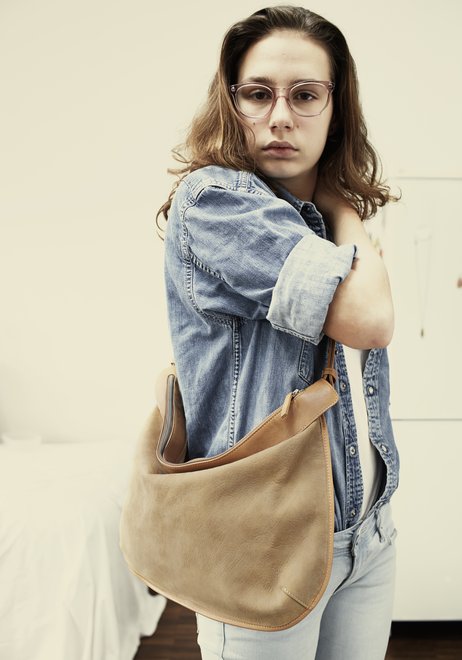We met Eva Buchleitner aka Eva Blut in her new little shop on the innercity street Kühfußgasse, beside the legendary Viennese coffee house Café Korb. This week she started into the new season with a small opening party. Read why bags are sometimes good replacements for lap-dogs, why constant bag-switchers are not destined to be her customers, and why handcraft literally runs “in her blood”.
We climb a steep and narrow staircase to a small gallery above the retail space. Here is Eva’s desk, a chair, and a few boxes. There’s not much space for anything more.
Stephanie Rugel: Your new shop has turned out quite nice! Who was the designer? This dynamic installation in the space stands out in particular – a curved, light wood lattice structure that resembles a garden arbor in the room.
Eva Blut: I commissioned the Viennese architect Claudia Cavallar with the design. She has a good nose for brands and shop design and is an exciting talent for dramatizing interiors. She chose the right approach: a subtle intervention in this small shop; even with the installation it doesn’t seem overloaded.
"The needs of my clients fluctuate between functionality and a good look."
The next question has been preying on my mind for some time now: Did you name your accessory label “Eva Blut” after the German “Blut” for blood, or is it a word game?
In the 90s I began with the design of bags. At that time bags were such hard things against the body that I didn’t want to carry them. So I asked myself: How can this relation be different, how can I create a different relationship with the body? And it just seemed natural that something physical should be in the name. The name should sound peculiar and unique. A label name that makes you imagine a fictional person behind it, who might also be a bit peculiar. (laughs)
"Actually it is about investigating new principles of configuring space"
The names of your bag collections are often formal descriptions, like “Cube”, for instance, in contrast to the Hermès Birkin or Kelly Bags, which refer to a specific person. Could you also imagine something like that for one of your creations?
Good question. At the moment I am actually pondering to make a series of bags that I will develop together with certain people. I’m thinking about friends of mine who I appreciate for their style or way of life. But yes, bag names such as “Twist” or “Cube”, in fact, describe types of spatial creations, and that – in my opinion – is what makes my bags special.
Is bag design architecture on a small scale?
Architecture can be so much! But yes, that’s it – it’s a definition of space. The relationship between body and object, body and space is also an issue.
"Different materials possess many different associative realms and thereby influence the atmospheres."
Describe your design approach: Do you begin with the inside or the outside of a bag?
Well, actually it is about investigating new principles of configuring space. Let’s take a look at the bag “Corolla” here...
Eva leans out, dangerously far, across the little wall that separates her elevated workplace from the “hanging closet”. That’s where she keeps her back-up supplies – bags in a range of different shapes, colors, and materials. And also the “Corolla”. It is dark-green and made of goatskin.
For example, you could spread the “Corolla” out into a flat surface. The form only comes into being by folding the leather up around the base area. And these things here – the outer pockets – they’re actually too much, but going without them is also not ideal as they are important design elements. At the same time, they naturally have an important function as well. And that is how I work: I think about what can be done with the geometrical and graphic primary forms. Sometimes it turns into something totally unexpected, which you don’t connect with the original form, but it is still there.
So your approach follows mathematical-geometrical principles?
Yes, but I go about it in a totally different way: The ideas float around in my head, then I start to experiment with paper and to work along different geometrical principles. Nevertheless, there’s nothing over-constructed. I think you could design something like this quite easily on a computer, but then you don’t come up with the little “this and thats”, the tricks and coincidences that turn up in the process of experimenting.
"My customers also appreciate the fact that they can bring the bag to me for repairs."
Design as an exciting process of experiments. What role do materials play?
More of a subordinate role, but ultimately the form only works when it is supported by the material. That’s a good thing as it has become a bit of a trademark for me in the meanwhile: Different materials possess many different associative realms and thereby influence the atmospheres. And there is an array of aesthetics possible within this formal language. I think it has become like a container in which you can mix together different things. And in the end you get a “good cocktail”.
And what kind of things are in your bag?
My calendar book, which is also my notebook, my telephone, my money. And often also a book.
What are you reading at the moment?
“The Master and Margarita” by Michail Bulgakow! By the way, I recently discovered that I only need a small bag. If it is made properly, it can hold a lot within it but in a way that doesn’t overstrain me. If I need more then I use an extra bag. Personally, I try to keep it modular. When I take the laptop and documents with me then I stick the small bag in the big one, and in the small bag I always have the things that I will definitely need, also for the evening.
You’re the classic bag-in-a-bag type!
Yes!
As an expert on the subject, you must have a special eye for such things: Do you judge people by the bags they carry?
Sure, you can definitely see if someone is more an orderly type or if they see a bag simply as a functional element, which is tagged onto the overall appearance. But sometimes it is almost like a love affair, or the bag is a surrogate for a pet on the lap. (laughs) There are all kinds of different attitudes!
Have you developed your own typology? What types are there?
Naturally, I know it best from my own clientele, so those people who are also interested in what I am doing here. My customers want to have things easy. The functional aspect is central for them – the bag has to be able to keep up with the changes that the individual personally experiences each day. Different situations, be it private or at work. It is not the “constant bag-switcher” rather someone who has their “main thing”. A person for whom aesthetics stands above everything else – that’s my clientele. And those types who aren’t really interested in the functional component, who actually just want shopping bag, they’re not really my target group either. The needs of my clients fluctuate between functionality and a good look.
"It’s important to me that my bags functionin a sustainable way."
So this It Bag story – every season another bag, which is THE bag – contradicts your philosophy?
That’s just a marketing gag by the large companies. Sure, you can play along if you like. But I believe that a self-confident woman knows for herself what she needs and what she likes, don’t you?
You have approached the major brands. Your label Eva Blut has existed for 20 years now and enjoys a high level of name recognition. Moreover, you have been present with your collections at the fairs in Paris since years. How do you see your position between the major fashion houses and High Street?
Well, I naturally found the most uncomfortable position for myself. (laughs) I design affordable yet high-quality bags for an affluent middle class, so to say. When the High Street brands communicate that you can get a leather bag for a fraction of the price, then the expectations of my clients unfortunately also shift as well. On the other hand, there are the big brands that posh it up and cast their precious pieces out into the world. I’m somewhere in-between: not emphatically glamorous, but definitely higher caliber than H&M, Cos, or Zara.
Are your products designed with a longer term usage in mind?
Yes, I have the desire to create something more credible – from the design to materials and production – beyond fashion’s restless pace, something that doesn’t just perpetuate itself into absurdity but represents an immanent facet of the fashion world. That’s why I create the nonseasonal line “Future Classics”. Furthermore, it’s important to me that my bags “function” in a sustainable way. My customers put money on the table for this thing and then often return again because they would like to try out a new form or the same thing in a different material. Or they are curious about a new function. They also appreciate the fact that they can bring the bag to me for repairs.
Where are your bags produced?
In Hungary and the Czech Republic. A main reason is that there isn’t anyone in Austria anymore who can produce serial works in the quality that I desire.
You give me the impression of being a hard worker – a “Hackler” as you would say in Austrian. Can that have to do with your roots in an Upper Austrian handcraft family?
You’re quite right! If I would have wanted, I could have spent my time in the metalworking shop. But I’m not such a big fan of iron as a material; it’s somehow too pointy and sharp, too hard. But from the very beginning it was clear to me that I wanted to spend my time producing something. I was sort of born with this “wanting to be productive”, but it was left open to me how I would be “productive”. My father would have liked that I take over his locksmithery, but things turned out differently. I already moved away from home at the age of 14, so I parted with a lot of family constraints quite early.
Where were you attracted to as a 14 year-old?
Hallein near Salzburg, I graduated from the fashion school there. They provided excellent basic training, technically superb. At that time, back in the 80s, they still taught for the textile industry. Thereafter, I designed for sportswear and traditional folk costume companies – today a lot of these companies don’t exist anymore. Then I wanted to study art, but I soon discovered that it was handcraft which really interested me – that’s how I ended up at the Vienna Fashion Institute in Hetzendorf in the leatherware class.
Is Vienna a good address for a bag designer, for someone who wants to be productive creatively?
No question! I love the quality of life in Vienna, and there are good funding programs, too. Very fertile conditions to sustain one’s own label. You know, I’m actually quite happy not to live in a fashion marketplace like Paris or London because you can simply work a bit freer in “backwoods” Vienna. But you can’t just lay back either – you still have to compete with the big fashion capitals in the end. It is always a good idea to build up strong networks. It is just a bit more difficult to do it from Vienna.
Did you ever come to the point where you thought, I’ll just throw in the hat and do something completely different?
There were two difficult phases and slumps, but I never pondered totally giving up my label work. When my two children were small, I was constantly switching between full gas and full stop. That required a lot of energy. On top of my label I was also teaching at Vienna Fashion Institute back then. And in 2010 I opened my first shop just around the corner from here. A year before, however, I made the fine decision to only produce accessories and no longer design clothing, which I was still doing previously. With these cuts I found my focus. Now I am doing precisely what I really want to be doing.
When you could choose a superpower right now, which one would it be?
To stretch time! (laughs) I would love to have more time and simultaneously have the same amount of energy available. Some days should just be longer!

